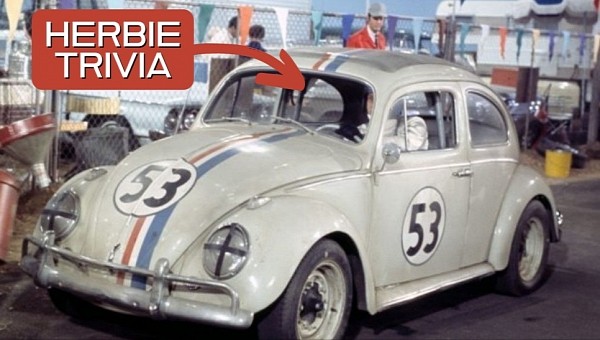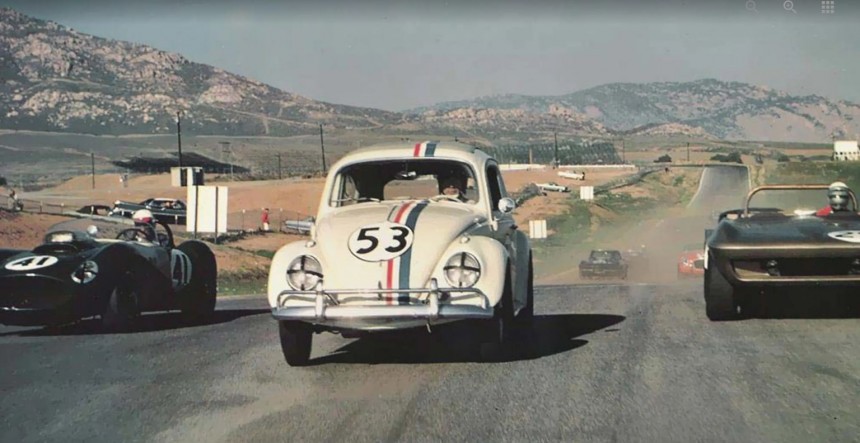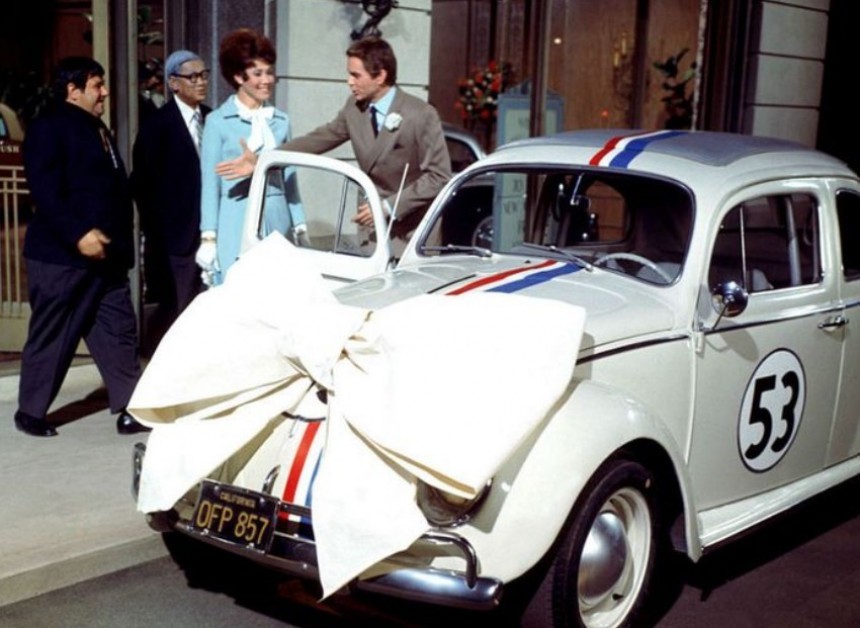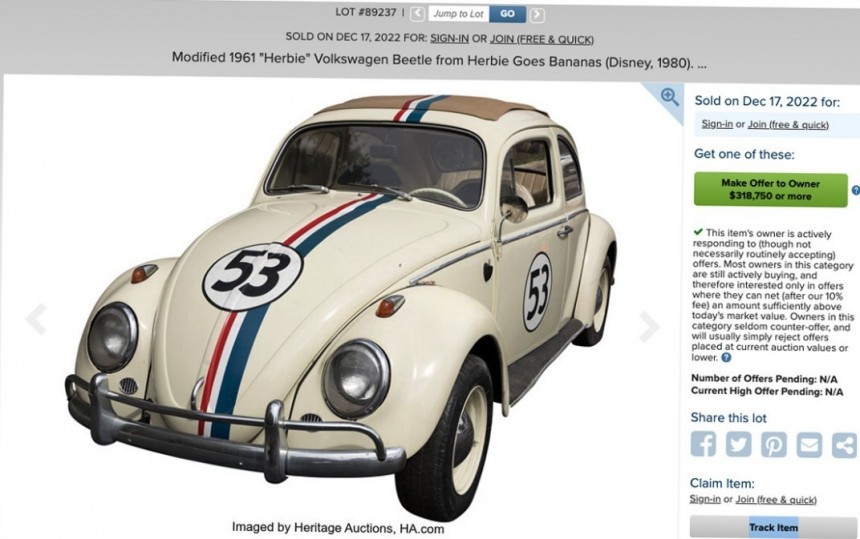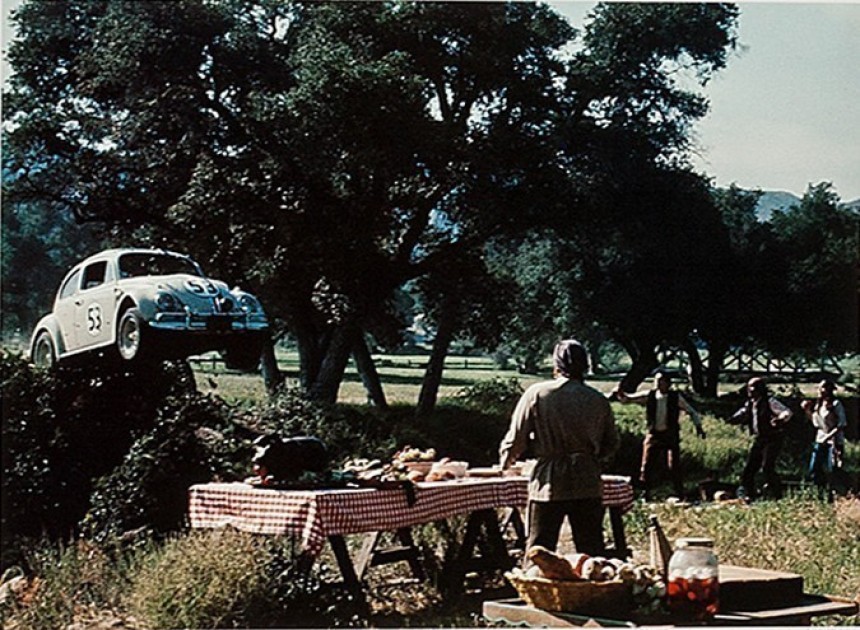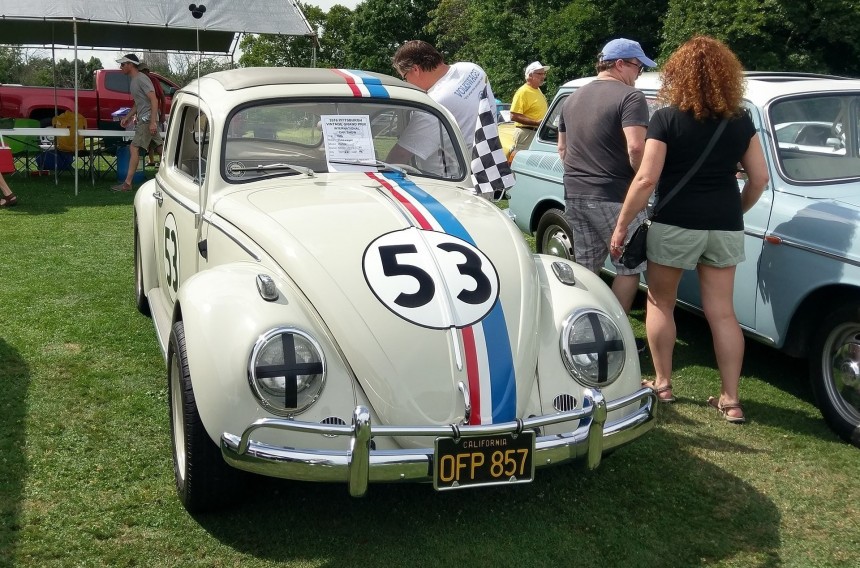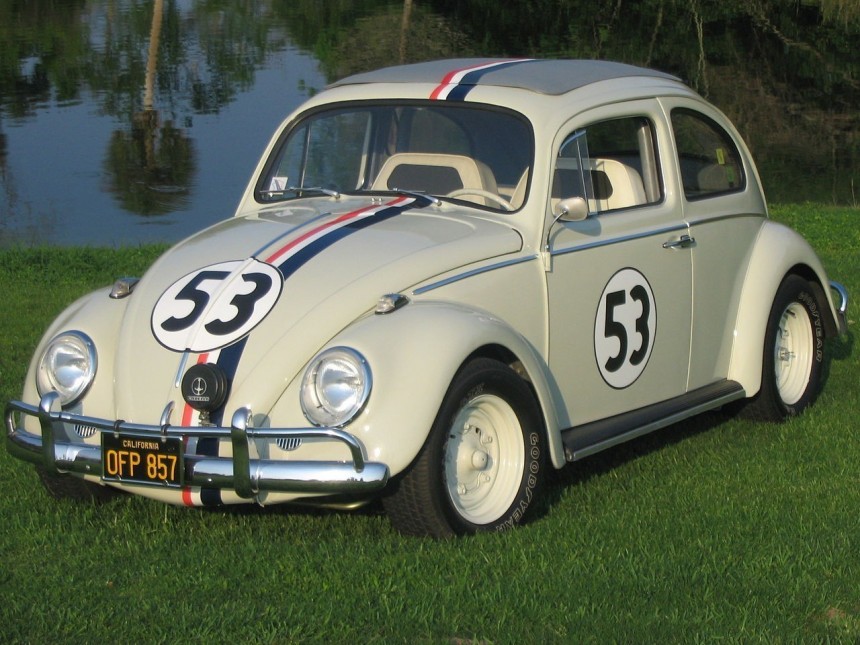Herbie first appeared in the 1968 movie The Love Bug. But it became so beloved that a series of movies and a TV series ensued, all including the Volkswagen Beetle.
Movies and television have been humanizing cars for decades, whether they become likable characters like the ones in the animation series Cars or evil ones like Christine, the red 1958 Plymouth Fury.
Some don't even need to be anthropomorphic to become iconic, and James Bond’s Aston Martin DB5, Gone in 60 Seconds' Ford Mustang called Eleanor, Batman's Batmobile, and Steve McQueen's Ford Mustang from Bullitt come to mind.
But we'll focus on the former category, and the 1968 movie The Love Bug brought on the screen one of the most likable and cute car characters, Herbie. The racing 1963 Volkswagen Beetle was so popular that it ended up becoming part of several movies and television series.
The Disney property car character loved car chases, racing, and testing his limits whenever he got a chance.
Starring Dean Jones, Michelle Lee, and a Volkswagen Beetle named Herbie, the first movie in the series became a cult classic, currently with a 6.5 rate on IMDb, and 78% on Rotten Tomatoes. And there are a lot of fun facts about it.
Rumor has it that, when production started, producer/writer Bill Walsh had about a dozen cars ready for an auto audition. Besides the pearl-white Volkswagen, there were also Toyotas, Volvos, an MG, and a TVR.
During breaks, the crew would go outside, where the cars were kept, and roughly inspect them. That included grabbing the steering wheel to check how it handled, kicking the tires, and so on.
But when they got to the Beetle, they were rather inclined to pet it and treat it nicely, and everyone was sold that it was the right choice.
And word is that there were as many as 50 for the first four movies. Which sounds plausible, because, just for the first one, they used over 20 different Volkswagen Type 1s, which was the official denomination of the commonly known Beetle.
Each one of the cars had different roles and was modified for different tasks, whether it was for racing or different angles.
#8 There was no VW logo in sight in The Love Bug
For the original movie, the carmaker didn’t allow the “people’s car” to officially star in the movie.
While that changed for the second installment in the series, for the first one, Disney had to adapt. They commissioned 11 cars devoid of the VW logo.
Out of them, only three survived production, and one of them was sold for a record $126,600 at a private auction.
There are a lot of fans out there who would like to own custom merch featuring their favorite artist, movie, or TV series. Cars make no exception.
Owning a car used in a movie usually sets you back more than a regular car from the same make and model, and such was also the case with Herbie.
The most expensive Herbie was also the priciest Beetle ever sold. In that case, it was a modified 1961 Beetle that appeared in the 1980 Disney film Herbie Goes Bananas, formerly displayed at the Planet Hollywood casino in Las Vegas, NV.
Under normal circumstances, the cabin would reflect the exterior with a matching white.
However, Herbie comes with a special non-reflective grey interior to avoid reflections from the cameras and studio lights.
It was all credited to one of the movie's star Buddy Hackett's Vegas skits about a ski instructor. Using a funny accent, Hackett said, “If you ain't got a Herbie, I ain't goin'.” And the name stuck. The movie, however, explains Herbie’s name was inspired by the middleweight boxer uncle of Hackett’s character
It also took a while to settle on the movie’s title. Among the choices the crew debated were Bugboom, The Magic Volksy, The Runaway Wagen, and Wonderbeetle. Eventually, they settled on The Love Bug to tell the story of the two-door lovable car with a mind of its own, capable of driving itself, and with a passion for racing.
Something you probably never knew was that one of the modified Volkswagens on set didn’t have a Volkswagen engine. But a Porsche one.
For the racing scenes, a standard 1200-cc Volkswagen with 40 horsepower wasn’t believable as a race car. So, one of the cars underwent modifications from the famous VW tuner EMPI, fitting it with a 90-horsepower 1600-cc twin-carburetor flat-four Porsche engine from a Porsche 356 “Super 90.” An upgraded suspension, Koni shocks, and new wheels were also among the changes.
With the new power boost, the upgraded Herbie could reach around 115 mph (185 kph) and was the star of most racing scenes. The car, called “Herbie number 2”, still has its modified Porsche engine and is located in the UK.
Besides Loftin, the other two members of the legendary Bullit trio, Bill Hickman and Bud Ekins, were also part of the cast.
Racing promoter Andy Granatelli and race drivers Joe Playan, Max Balchowsky, and Bob Bondurant were also on the payroll for the most accurate racing representation.
The iconic #53 had its own significance. It appears in the middle of the hood and both side doors, painted in black within a black-ringed white circle.
The producer, Bill Walsh, was a huge baseball fan. So he selected the number to pay homage to Los Angeles Dodgers pitcher Don Drysdale.
It also included red, white, and blue racing stripes, the latter slightly larger, which were reportedly chosen for a patriotic theme.
#1 Herbie’s License Plate
Herbie has a lot of meanings, as we’ve seen so far. So why would its license plate be something random?
It turns out that the car’s plate, which reads “OFP 857” stands for “Our First Production 8-57", has something to do with the movie’s director, Robert Stevenson. It signifies the month and year Stevenson started working for Disney, ahead of starting his gig for The Love Bug.
The yellow-on-black California license plates stayed with the car until 2005's Herbie Fully Loaded.
Some don't even need to be anthropomorphic to become iconic, and James Bond’s Aston Martin DB5, Gone in 60 Seconds' Ford Mustang called Eleanor, Batman's Batmobile, and Steve McQueen's Ford Mustang from Bullitt come to mind.
But we'll focus on the former category, and the 1968 movie The Love Bug brought on the screen one of the most likable and cute car characters, Herbie. The racing 1963 Volkswagen Beetle was so popular that it ended up becoming part of several movies and television series.
The Disney property car character loved car chases, racing, and testing his limits whenever he got a chance.
Starring Dean Jones, Michelle Lee, and a Volkswagen Beetle named Herbie, the first movie in the series became a cult classic, currently with a 6.5 rate on IMDb, and 78% on Rotten Tomatoes. And there are a lot of fun facts about it.
#10 Herbie was not always a Volkswagen
During breaks, the crew would go outside, where the cars were kept, and roughly inspect them. That included grabbing the steering wheel to check how it handled, kicking the tires, and so on.
But when they got to the Beetle, they were rather inclined to pet it and treat it nicely, and everyone was sold that it was the right choice.
#9 There was not just one Volkswagen Beetle
This one sounds like common sense, but, over the years, there were many cars used in production.And word is that there were as many as 50 for the first four movies. Which sounds plausible, because, just for the first one, they used over 20 different Volkswagen Type 1s, which was the official denomination of the commonly known Beetle.
Each one of the cars had different roles and was modified for different tasks, whether it was for racing or different angles.
#8 There was no VW logo in sight in The Love Bug
While that changed for the second installment in the series, for the first one, Disney had to adapt. They commissioned 11 cars devoid of the VW logo.
Out of them, only three survived production, and one of them was sold for a record $126,600 at a private auction.
#7 Most expensive Herbie
Owning a car used in a movie usually sets you back more than a regular car from the same make and model, and such was also the case with Herbie.
The most expensive Herbie was also the priciest Beetle ever sold. In that case, it was a modified 1961 Beetle that appeared in the 1980 Disney film Herbie Goes Bananas, formerly displayed at the Planet Hollywood casino in Las Vegas, NV.
#6 Not a white-on-white Beetle for a reason
The Herbie from the first movie was a 1963 Volkswagen Beetle deluxe ragtop sedan. It came with the now-iconic L87 pearl white paint job.Under normal circumstances, the cabin would reflect the exterior with a matching white.
However, Herbie comes with a special non-reflective grey interior to avoid reflections from the cameras and studio lights.
#5 How did they come up with Herbie?
Now an iconic car character name, Herbie got its name by accident.It was all credited to one of the movie's star Buddy Hackett's Vegas skits about a ski instructor. Using a funny accent, Hackett said, “If you ain't got a Herbie, I ain't goin'.” And the name stuck. The movie, however, explains Herbie’s name was inspired by the middleweight boxer uncle of Hackett’s character
It also took a while to settle on the movie’s title. Among the choices the crew debated were Bugboom, The Magic Volksy, The Runaway Wagen, and Wonderbeetle. Eventually, they settled on The Love Bug to tell the story of the two-door lovable car with a mind of its own, capable of driving itself, and with a passion for racing.
#4 A Volkswagen with a Porsche engine
For the racing scenes, a standard 1200-cc Volkswagen with 40 horsepower wasn’t believable as a race car. So, one of the cars underwent modifications from the famous VW tuner EMPI, fitting it with a 90-horsepower 1600-cc twin-carburetor flat-four Porsche engine from a Porsche 356 “Super 90.” An upgraded suspension, Koni shocks, and new wheels were also among the changes.
With the new power boost, the upgraded Herbie could reach around 115 mph (185 kph) and was the star of most racing scenes. The car, called “Herbie number 2”, still has its modified Porsche engine and is located in the UK.
#3 Real race drivers were in the cast
Acclaimed stunt driver Carey Loftin was in charge of the racing scenes.Besides Loftin, the other two members of the legendary Bullit trio, Bill Hickman and Bud Ekins, were also part of the cast.
Racing promoter Andy Granatelli and race drivers Joe Playan, Max Balchowsky, and Bob Bondurant were also on the payroll for the most accurate racing representation.
#2 No 53
The producer, Bill Walsh, was a huge baseball fan. So he selected the number to pay homage to Los Angeles Dodgers pitcher Don Drysdale.
It also included red, white, and blue racing stripes, the latter slightly larger, which were reportedly chosen for a patriotic theme.
#1 Herbie’s License Plate
Herbie has a lot of meanings, as we’ve seen so far. So why would its license plate be something random?
It turns out that the car’s plate, which reads “OFP 857” stands for “Our First Production 8-57", has something to do with the movie’s director, Robert Stevenson. It signifies the month and year Stevenson started working for Disney, ahead of starting his gig for The Love Bug.
The yellow-on-black California license plates stayed with the car until 2005's Herbie Fully Loaded.
